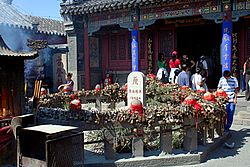| Feng Shan sacrifice | |
|---|---|
 Jade Emperor Peak, the summit of Mt. Tai | |
| Organised by | Emperor of China |
Feng Shan or feng-shan (Chinese: 封禪), also referred to as the Feng and Shan sacrifices, was an official rite offered by the Son of Heaven (kings of Zhou and later emperors of China) to pay homage to heaven and earth. The sacrifices were usually offered at Mount Tai,[1] the highest peak in the area, and nearby Mount Liangfu. The emperor would pay homage to heaven (on the summit) and earth (at the foot of the mountain) in the Feng (Chinese: 封; pinyin: Fēng) and Shan (Chinese: 禪; pinyin: Shàn) sacrifices respectively.[2] Completing Feng Shan allowed the emperor to receive the mandate of heaven.[3] The term 'feng' can roughly be translated to mean "to seal", while the term 'shan' can roughly be translated to mean "to clear away".
It is considered among the most important rituals of religious Confucianism.[4]
According to the Records of the Grand Historian, Feng involved building altars out of soil at the peak of Mt. Tai and proclaiming the merits and legitimacy of the emperor to god of heaven. Shan involved clearing land at the foot of the mountain to show respect for the god of earth.[5][6]
It was seen as a point by which emperors could meditate on the relationship between heaven and earth.[7]
While historically considered limited to the Emperor, commoners have performed the ceremony at times without imperial permission.[8] The general Huo Qubing did it alone.[8]
It is considered a prerequisite that the empire is in a period of prosperity with a good emperor and auspicious signs to perform the ritual.[9] Many sovereigns refused to perform the ritual citing themselves as unworthy of it.[4]
They are considered parallel to the Secular Games of the Roman Empire in their political role with both being highly infrequent celebrations.[10] Both had high religious significance and were influential in changing narratives of power.[10]
- ^ Guangwei, He; Hualing, Tong; Wenzhen, Yang; Zhenguo, Chang; Zeru, Li; Ruicheng, Dong; Weijan, Gong, eds. (1999). Spectacular China. Translated by Wusun, Lin; Zhongping, Wu. Cologne: Könemann. p. 42. ISBN 9783829010771.
- ^ Lewis, Mark Edward (18 March 1999). Writing and Authority in Early China. SUNY Press. ISBN 9780791441145. Retrieved 31 January 2015.
- ^ Jing, Wang (1992). The Story of Stone: Intertextuality, Ancient Chinese Stone Lore, and the Stone Symbolism in Dream of the Red Chamber, Water Margin, and The Journey to the West. Durham, North Carolina: Duke Press. pp. 66–69. ISBN 082231195X.
- ^ a b Bokenkamp, Stephen (2002). "24. Record of the Feng and Shan Sacrifices". Religions of Asia in Practice. Princeton University Press. pp. 386–395. doi:10.1515/9780691188140-029. ISBN 9780691188140.
- ^ "'Fengshan Sacrifices' at Mount Tai[1]- Taian". www.chinadaily.com.cn. Retrieved 2019-02-25.
- ^ Daji, Lü (2014). Marxism and Religion. Religious Studies in Contemporary China Collection. BRILL. ISBN 978-9047428022.
- ^ "'Fengshan Sacrifices' at Mount Tai[2]- Taian". www.chinadaily.com.cn. Retrieved 2023-02-12.
- ^ a b Theobald, Ulrich. "fengshan 封禪 (http://www.chinaknowledge.de)". www.chinaknowledge.de. Retrieved 2023-02-12.
- ^ "Mount Tai - Holy Land of Politic and Worship | ChinaFetching". ChinaFetching.com. Retrieved 2023-02-12.
- ^ a b ROBINSON, REBECCA (2018). "Spectacular Power in the Early Han and Roman Empires". Journal of World History. 29 (3): 343–368. ISSN 1045-6007. JSTOR 26607626.